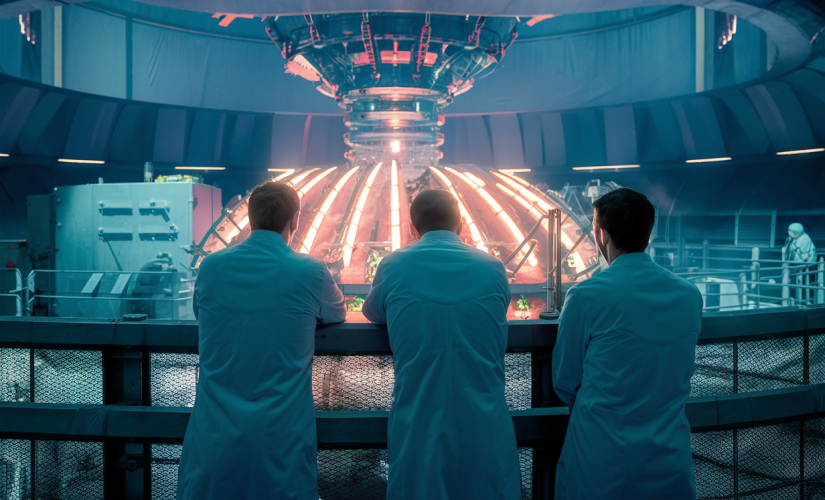Unlimited Clean Power: MIT Breakthrough Paves the Way for Fusion Energy
MIT Researchers Publish Key Findings Advancing Humanity Towards Unlimited Carbon-Free Energy through Fusion Reactors
MIT researchers make fusion energy breakthrough
📅 Last Updated: Mar 4, 2024
🔧 Industrial / 🖥️ Tech

In a groundbreaking achievement, Massachusetts Institute of Technology (MIT) engineers have successfully tested a high-temperature superconducting magnet capable of generating a world-record 20-tesla magnetic field strength. This milestone is a major step forward in making practical fusion power plants a reality.
Nearly three years after the initial breakthrough, MIT researchers have published a comprehensive analysis validating their record-breaking superconducting magnet technology. This analysis serves as a crucial step towards the commercialization of fusion reactors, which could provide unlimited clean power.
💡 Deeper Insights into Fusion Power
At its core, fusion power aims to replicate the nuclear fusion process that powers the sun. By fusing light atomic nuclei, fusion can unleash immense amounts of energy. If harnessed on Earth, fusion power could offer virtually limitless, carbon-free energy with minimal radioactive waste. However, achieving the extreme temperatures and pressures required for fusion has remained a significant challenge.
😲 Revolutionizing the Cost of Fusion Reactors
The breakthrough lies in the magnet’s construction, which utilizes a superconducting material called REBCO. This material can operate at a higher temperature of 20 kelvins, eliminating the need for complex insulation between conductor windings. The “no-insulation” design simplifies fabrication and significantly reduces the cost per watt of fusion reactors. In fact, the cost was reduced by almost 40 times overnight, according to Dennis Whyte, former director of MIT’s Plasma Science and Fusion Center.
🔬 Thorough Testing and Resilience
The superconducting magnet underwent rigorous testing, including deliberate attempts to push it beyond its limits. Researchers induced a “quench,” intentionally overheating the magnet to simulate worst-case operating conditions. Surprisingly, the magnet survived these extreme conditions with minimal damage, providing valuable insights into its physics and optimizing its future development.
🤝 Collaboration Leads to Success
Both MIT and the private sector collaborated closely to achieve this significant breakthrough. By combining academic knowledge with industry expertise, they leveraged the strengths of each to make substantial progress in a relatively short timeframe. The decades of fusion research and expertise at MIT’s facilities played a crucial role in the project’s success.
🔮 Future Prospects and Impact
The successful validation of MIT’s record-breaking magnet technology opens up new possibilities for the construction of SPARC, a compact fusion device developed by Commonwealth Fusion Systems (CFS). This progress not only brings the prospect of fusion power closer to reality but also highlights the potential for collaborative efforts between academia and industry to drive technological advancements.
🎯 Frequently Asked Questions
Q: How does fusion power work? A: Fusion power involves fusing light atomic nuclei to release massive amounts of energy, replicating the process that powers the sun. If achieved on Earth, fusion power could provide a virtually limitless and carbon-free energy source with minimal radioactive waste.
Q: Why is the recent magnet breakthrough significant? A: The recent breakthrough in magnet technology allows for higher magnetic field strengths at a reduced cost. It paves the way for the development of fusion power plants that are economically viable, bringing us closer to a future of clean and sustainable energy.
Q: How did MIT and the private sector collaborate to achieve this breakthrough? A: The collaboration between MIT and Commonwealth Fusion Systems (CFS) was a critical factor in the success of this breakthrough. By combining the expertise and resources of academia and industry, they accelerated the development of the magnet technology and brought fusion power closer to reality.
Q: What are the potential future developments in fusion power? A: The successful validation of the magnet technology opens up the possibility for the construction of SPARC, a compact fusion device. Continued research and development could lead to the creation of commercial fusion reactors, providing a reliable and clean energy source for the future.
🔗 Reference Links
- Sam Altman’s Firing and the OpenAI Fallout (TechCrunch)
- Asml Stock Price Dips as Netherlands Revokes China Export License (Enble)
- Tech Palestine Launches to Provide Tools to Help and Support Palestinians (TechCrunch)
- Thea Energy Raises $20M Series Pixel-Inspired Fusion Power Plants (TechCrunch)
- New MIT CSAIL Study Suggests AI Will Steal More Jobs Than Expected (TechCrunch)
🔗 Learn more about the author, Sam Shedden, a Managing Editor with extensive experience in technology writing and content strategy.
Now, it’s your turn! What are your thoughts on this groundbreaking fusion power development? Share your views in the comments below and don’t forget to share this article with fellow tech enthusiasts! 👩💻👨💻
Markdown version available upon request.






